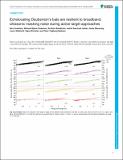Echolocating Daubenton's bats are resilient to broadband, ultrasonic masking noise during active target approaches
Abstract
Echolocating bats hunt prey on the wing under conditions of poor lighting by emission of loud calls and subsequent auditory processing of weak returning echoes. To do so, they need adequate echo-tonoise ratios (ENRs) to detect and distinguish target echoes from masking noise. Early obstacle avoidance experiments report high resilience to masking in free-flying bats, but whether this is due to spectral or spatiotemporal release from masking, advanced auditory signal detection or an increase in call amplitude (Lombard effect) remains unresolved. We hypothesized that bats with no spectral, spatial or temporal release from masking noise defend a certain ENR via a Lombard effect. We trained four bats (Myotis daubentonii) to approach and land on a target that broadcasted broadband noise at four different levels. An array of seven microphones enabled acoustic localization of the bats and source level estimation of their approach calls. Call duration and peak frequency did not change, but average call source levels (SLRMS, at 0.1 m as dB re. 20 μPa) increased, from 112 dB in the no-noise treatment, to 118 dB (maximum 129 dB) at the maximum noise level of 94 dB re. 20 μPa root mean square. The magnitude of the Lombard effect was small (0.13 dB SLRMS dB-1 of noise), resulting in mean broadband and narrowband ENRs of -11 and 8 dB, respectively, at the highest noise level. Despite these poor ENRs, the bats still performed echo-guided landings, making us conclude that they are very resilient to masking even when they cannot avoid it spectrally, spatially or temporally.
Citation
Foskolos , I , Pedersen , M B , Beedholm , K , Uebel , A S , MacAulay , J , Stidsholt , L , Brinkløv , S & Madsen , P T 2022 , ' Echolocating Daubenton's bats are resilient to broadband, ultrasonic masking noise during active target approaches ' , Journal of Experimental Biology , vol. 225 , no. 3 , jeb242957 . https://doi.org/10.1242/jeb.242957
Publication
Journal of Experimental Biology
Status
Peer reviewed
ISSN
0022-0949Type
Journal article
Description
This study was funded by a Carlsberg Semper Ardens grant to P.T.M.Collections
Items in the St Andrews Research Repository are protected by copyright, with all rights reserved, unless otherwise indicated.

